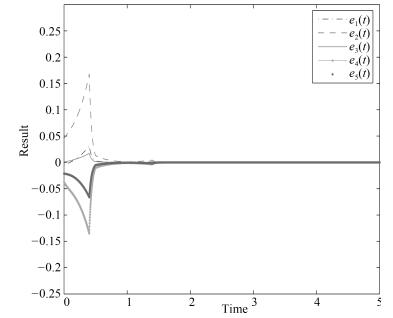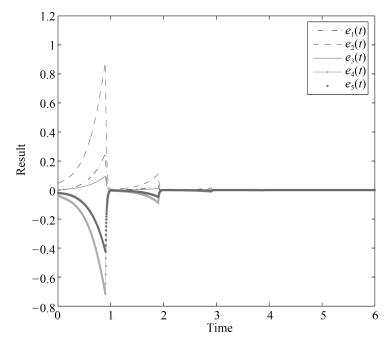|
[1]
|
Chua L O. Memristor-the missing circuit element. IEEE Transaction on Circuit Theory, 1971, 18(5): 507-519 doi: 10.1109/TCT.1971.1083337
|
|
[2]
|
Strukov D B, Snider G S, Stewartand D R, Williams R S. The missing memristor found. Nature, 2008, 453: 80-83 doi: 10.1038/nature06932
|
|
[3]
|
Itoh M, Chua L O. Memristor oscillators. International Journal of Bifurcation and Chaos, 2008, 18(11): 3183-3206 doi: 10.1142/S0218127408022354
|
|
[4]
|
Ventra M D, Pershin Y V, Chua L O. Circuit elements with memory: memristors, memcapacitors, and meminductors. Proceedings of the IEEE, 2009, 9(10): 1715-1716 http://d.old.wanfangdata.com.cn/OAPaper/oai_arXiv.org_0901.3682
|
|
[5]
|
Guckert L, Swartzlander E E. Optimized memristor-based multipliers. IEEE Transaction on Circuits and Systems Ⅰ, 2017, 64(2): 373-385 doi: 10.1109/TCSI.2016.2606433
|
|
[6]
|
Wu A, Wen S, Zeng Z. Synchronization control of a class of memristor-based recurrent neural networks. Information Science, 2012, 183(1): 106-116 doi: 10.1016/j.ins.2011.07.044
|
|
[7]
|
李传东, 葛均辉, 田园.脉冲神经网络的忆阻器突触联想学习电路分析.重庆大学学报, 2014, 37(7): 115-124 http://d.old.wanfangdata.com.cn/Periodical/cqdxxb201407016Li Chuan-Dong, Ge Jun-Hui, Tian Yuan. Associative learning of memristive synapses circuits based on spiking neural networks. Journal of Chongqing University, 2014, 37(7):115-124 http://d.old.wanfangdata.com.cn/Periodical/cqdxxb201407016
|
|
[8]
|
Wu A, Zeng Z. Exponential stabilization of memristive neural networks with time delays. IEEE Transactions on Neural Networks & Learning Systems, 2012, 23(12): 1919-1929 http://europepmc.org/abstract/med/24808147
|
|
[9]
|
Wu H, Li R, Yao R, Zhang X. Weak, modifled and function projective synchronization of chaotic memristive neural networks with time delays. Neurocomputing, 2015, 149:667-676 doi: 10.1016/j.neucom.2014.08.008
|
|
[10]
|
Wu H, Li R, Wei H, Zhang X, Yao R. Synchronization of a class of memristive neural networks with time delays via sampled-data control. International Journal of Machine Learning and Cybernetics, 2015, 6(3): 365-373 doi: 10.1007/s13042-014-0271-z
|
|
[11]
|
Wu A. Hyperchaos synchronization of memristor oscillator system via combination scheme. Advances in Difierence Equations, 2014, DOI: 10.1186/1687-1847-2014-86
|
|
[12]
|
Wen S, Zeng Z, Huang T, Chen Y. Fuzzy modeling and synchronization of difierent memristorbased chaotic circuits. Physics Letters A, 2013, DOI: 10.1016/j.physleta.2013.05.046
|
|
[13]
|
Vaidyanathan S, Pham VT, Volos C. Adaptive control, synchronization and circuit simulation of a memristor-based hyperchaotic system with hidden attractors. Advances in Memristors, Memristive Devices and Systems, 2017, DOI: 10.1007/978-3-319-51724-7_5
|
|
[14]
|
Yang Z, Xu D. Stability analysis and design of impulsive control systems with time delay. IEEE Transactions on Automatic Control, 2007, 52(8): 1448-1454 doi: 10.1109/TAC.2007.902748
|
|
[15]
|
Fu X, Zhu Q. Stability of nonlinear impulsive stochastic systems with Markovian switching under generalized average dwell time condition. Science China Information Sciences, 2018, DOI: 10.1007/s11432-018-9496-6
|
|
[16]
|
Guan Z, Chen L, Ueta T. On impulsive control of a periodically forced chaotic pendulum system. IEEE Transactions on Automatic Control, 2000, 45(9): 1724-1727 doi: 10.1109/9.880633
|
|
[17]
|
Huang T, Li C, Duan S, Starzyk J A. Robust exponential stability of uncertain delayed neural networks with stochastic perturbation and impulse efiects. IEEE Transactions On Neural Networks And Learning Systems, 2012, 23(6):866-875 doi: 10.1109/TNNLS.2012.2192135
|
|
[18]
|
Feng Y, Zou L, Tu Z. Stability analysis for a class of nonlinear impulsive switched systems. The Journal of Nonlinear Sciences and Applications, 2017, 10: 4544-4551 doi: 10.22436/jnsa.010.08.46
|
|
[19]
|
Li D, Wang S, Zhang X, Yang D. Impulsive control for permanent magnet synchronous motors with uncertainties: LMI approach. Chinese Physics B, 2010, 19(1): 160-166 doi: 10.1088/1674-1056/19/1/010506
|
|
[20]
|
Hu C, Jiang H. Stabilization and synchronization of unifled chaotic system via impulsive control. Abstract and Applied Analysis, 2014, DOI: 10.1155/2014/369842
|
|
[21]
|
Y. Feng, C. Li, Huang T. Sandwich control systems with impulse time windows. International Journal of Machine Learning and Cybernetics, 2016, DOI: 10.1007/s13042-016-0580-5
|
|
[22]
|
Jiang Y, Li C. Globally exponential stability of memristive neural networks with time-varying delays and synchronous switching. Acta Automatica Sinica, 2017, 43(8): 1465-1469 http://www.wanfangdata.com.cn/details/detail.do?_type=perio&id=zdhxb201708018
|
|
[23]
|
Zou L, Peng Y, Feng Y, Tu Z. Impulsive control of nonlinear systems with impulse time window and bounded gain error. Nonlinear Analysis: Modelling and Control, 2018, 23(1): 40-49 http://www.researchgate.net/publication/322400071_Impulsive_control_of_nonlinear_systems_with_impulse_time_window_and_bounded_gain_error
|
|
[24]
|
Zhang G, Zeng Z. Exponential stability for a class of memristive neural networks with mixed time-varying delays. Applied Mathematics & Computation, 2018, 321: 544-554 http://www.ingentaconnect.com/content/el/00963003/2018/00000321/00000001/art00033
|
|
[25]
|
Luo Y P, Xia W H, Liu G R, Deng F Q. LMI approach to exponential stabilization of distributed parameter control systems with delay. Acta Automatica Sinica, 2009, 35(3): 299-304 http://www.ams.org/mathscinet-getitem?mr=2535951
|
|
[26]
|
Liu H, Wang Z, Shen B. Stability analysis for discrete-time stochastic memristive neural networks with both leakage and probabilistic delays. Neural Networks, 2018, 102: 1-9 doi: 10.1016/j.neunet.2018.02.003
|
|
[27]
|
周笔锋, 罗毅平.时滞分布参数系统中和控制器设计.自动化学报, 2018, 44(12): 2222-2227 doi: 10.16383/j.aas.2018.c170084Zhou Bi-Feng, Luo Yi-Ping. Neutralization Control of Distributed Parameter Systems With Delay. Acta Automatica Sinica, 2018, 44(12): 2222-2227 doi: 10.16383/j.aas.2018.c170084
|
|
[28]
|
Yang X, Ho D W C. Synchronization of delayed memristive neural networks: robust analysis approach. IEEE Transactions on Cybernetics, 2016, 46(12): 3377-3387 doi: 10.1109/TCYB.2015.2505903
|
|
[29]
|
包伯成, 王其红, 许建平.基于忆阻元件的五阶混沌电路研究.电路与系统学报, 2011, 16(2): 66-70 doi: 10.3969/j.issn.1007-0249.2011.02.013Bao Bo-Cheng, Wang Qi-Hong, Xu Jian-Ping. On memristor based flve-order chaotic circuit. Journal of Circuits and Systems, 2011, 16(2): 66-70 doi: 10.3969/j.issn.1007-0249.2011.02.013
|
|
[30]
|
Li Q, Liu S. Adaptive modifled function projective lag synchronization of memristor-based flve-order chaotic circuit systems. Advances in Mathematical Physics, 2017, 2017(5):1-8 http://www.researchgate.net/publication/315598475_Adaptive_Modified_Function_Projective_Lag_Synchronization_of_Memristor-Based_Five-Order_Chaotic_Circuit_Systems
|
|
[31]
|
Sanchez E N, Perez J P. Input-to-state stability (ISS) analysis for dynamic neural networks. IEEE Transactions on Circuits Systems-Ⅰ, 1999, 46(11): 1395-1398 doi: 10.1109/81.802844
|





 下载:
下载:







